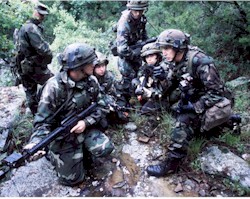|
Medical Education Division |
Operational Medicine 2001
Field Medical Service School
Student Handbook

CAMOUFLAGE,
COVER, AND CONCEALMENT
01
Nov 99
LESSON
PUPOSE. To introduce and instruct the students on the techniques for
applying camouflage, for utilizing cover and concealment, and for observing and
recognizing enemy emplacements. OUTLINE. A.
DEFINITIONS
a.
Natural
Cover. Natural cover includes logs, trees, stumps, ravines, hollows,
reverse slopes, and so forth. b.
Artificial
Cover. Artificial cover includes fighting holes, trenches, walls,
rubble, and craters.
a.
Natural
Concealment. Natural concealment is provided by the surroundings and needs
no change such as bushes, grass, and shadows. b.
Artificial
Concealment. Artificial concealment is made from materials such as burlaps
or nets or from natural materials such as bushes, leaves, and grass moved from
their original location.
B.
TECHNIQUES.
a.
If
possible build overhead cover. b.
Observe
and fire around the side of an object. c.
Use
routes which put cover between the unit and the enemy (i.e., gullies, draws). d.
Take
advantage of natural cover (i.e., wooded areas, hills, rock formations). e.
Avoid
open fields.
a.
Movement
draws attention. Avoid unnecessary
movement. b.
Shadows
draw attention. Break up shadows of
fighting positions and equipment. c.
Fighting
positions should be where the enemy does not expect to find them. d.
Shiny
objects draw attention. Conceal
shiny objects (i.e., watches, compasses, bayonet).
a.
Study the
terrain and vegetation of the area. Grass,
leaves, etc. must be arranged to conform to the area.
Tree branches stuck into the ground in and open field will not fool
anyone. b.
Camouflage
and hide dirt from fighting holes and heads. c.
Use only
material that is needed. Too much
material may call attention to a position as easily as too little. d.
Camouflage
is continuous. Always improve your
camouflage. Practice camouflage
discipline. e.
Always
inspect positions from the enemy point of view. f.
Alter the
distinctive silhouette of the helmet. g.
Exposed
skin reflects light and draws attention. Even
very dark skin, because of its natural oils, will reflect light. REFERENCE: Marine
Rifle Squad, 6-5
Field Medical Service School
Approved for public release; Distribution is unlimited. The listing of any non-Federal product in this CD is not an endorsement of the product itself, but simply an acknowledgement of the source. Operational Medicine 2001 Home · Military Medicine · Sick Call · Basic Exams · Medical Procedures · Lab and X-ray · The Pharmacy · The Library · Equipment · Patient Transport · Medical Force Protection · Operational Safety · Operational Settings · Special Operations · Humanitarian Missions · Instructions/Orders · Other Agencies · Video Gallery · Phone Consultation · Forms · Web Links · Acknowledgements · Help · Feedback
*This web version is provided by The Brookside Associates Medical Education Division. It contains original contents from the official US Navy NAVMED P-5139, but has been reformatted for web access and includes advertising and links that were not present in the original version. This web version has not been approved by the Department of the Navy or the Department of Defense. The presence of any advertising on these pages does not constitute an endorsement of that product or service by either the US Department of Defense or the Brookside Associates. The Brookside Associates is a private organization, not affiliated with the United States Department of Defense. |

